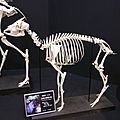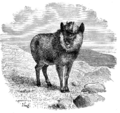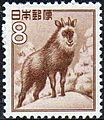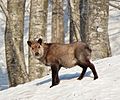Japanese serow facts for kids
The Japanese serow is a unique mammal that lives only in Japan. It's a type of goat-antelope, known for its shaggy coat and short horns. This animal is a special symbol of Japan and is protected in many areas.
Contents
What Does a Japanese Serow Look Like?
Adult Japanese serows are about 81 centimetres (32 inches) tall. They usually weigh between 30 and 45 kilograms (66 to 99 pounds). Their fur can be black or whitish. It often gets lighter in color during the summer months.
Where Do Japanese Serows Live?
Japanese serows make their homes in the thick forests of Japan. You can find them mainly in the northern and central parts of Honshu, which is Japan's largest island. They prefer dense mountain forests and open grasslands. These animals often live at high elevations, around 1,000 metres (3,300 feet) above sea level. They sometimes use caves as places to rest and hide.
What Do Japanese Serows Eat?
Japanese serows are herbivores, meaning they eat plants. Their diet includes different types of leaves and young shoots from plants. They also enjoy eating acorns, which are the nuts from oak trees.
Threats to Japanese Serows
One of the main threats to Japanese serows is illness. They can sometimes get infectious diseases. These diseases can spread among the animals and affect their health.
Reproduction and Life Cycle
Japanese serows usually live in pairs, meaning a male and a female stay together. This is known as being socially monogamous. They raise their young together.
Relationship with Humans
The Japanese serow is a very important animal in Japan. It is seen as a national symbol of the country. Because of its special status, the Japanese serow is protected. Many conservation areas have been set up to keep them safe.
Images for kids
-
Capricornis has sometimes been classified as Naemorhedus together with gorals (pictured: Naemorhedus caudatus or long-tailed goral).
-
Capricornis crispus skeleton at the Ōji Zoo in Kobe, Japan
-
Capricornis crispus, or the Japanese serow (Frank Evers Beddard, 1902).
-
The Japanese serow featured on a 1952 ¥8 stamp.
See also
 In Spanish: Serau japonés para niños
In Spanish: Serau japonés para niños












